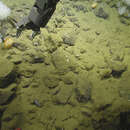Comprehensive Description
(
englanti
)
tarjonnut Smithsonian Contributions to Zoology
Malmgreniella macginitiei
Harmothoe lunulata.—Berkeley and Berkeley, 1941:21 [part; not Delle Chiaje, 1830].
Malmgeniella lunulata.—Pettibone, 1953:25 [part], pl. 9: fig. 77; pl. 10: figs. 80–82,85, 87; pl. 11: figs. 92–95 [not Delle Chiaje, 1830].
Harmothoe of. lunulata.—Kudenov, 1975a:42, fig. la–g [not Delle Chiaje, 1830].
MATERIAL EXAMINED.—EASTERN PACIFIC OCEAN: Central California: Tomales Bay, sandy mud flat, in burrow with ghost shrimp Callianassa californiensis Dana, 28 May 1941, F. Pitelka and R. Paulson, collectors, holotype (USNM 24933). Tomales Bay, Lawson's Flat, in tube of maldanid Axiothella rubrocincta (Johnson), 31 Jan 1970, J.K. Kudenov, collector, paratype (AHF 1119, as H. cf. lunulata by Kudenov, 1975a). Southern California: Newport Bay, Mar 1933, in burrow with Callianassa californiensis, G.E. MacGinitie, collector, paratype (USNM 55059, as H. lunulata by Berkeley and Berkeley, 1941). Santa Monica Bay, 60 m, on arm of Amphiodia urtica (Lyman), M/V Marine Surveyor, from G. Hendler, 1 specimen (USNM 133564).
DESCRIPTION.—Holotype from Tomales Bay, male with sperm, 13 mm long, 4.5 mm wide including setae, with 35 segments, last one minute. Paratype from same area (AHF 1119), female with eggs, 9 mm long, 3.5 mm wide, with 34 segments. Paratype from Newport Bay (USNM 55059), female with eggs, 14 mm long, 5 mm wide, with 37 segments. Body darkly pigmented or with dorsal and ventral transverse dark bands in posterior region. Elytra 15 pairs, on usual segments, rounded to subreniform, with anterior group of microtubercles on some anterior elytra; central part of elytra showing compartments, with or without pigment; pigmentation forming C-shape pattern on central, median, and posterior areas; some scattered round micropapillae on surface and border (Figure 45C,D); Pettibone, 1953, pl. 10: figs. 80–82; Kudenov, 1975a, fig. 1c).
Bilobed prostomium with anterior lobes wide, subconical, with distinct peaks; eyes moderate in size, anterior pair anterolateral, anterior to greatest width of prostomium, slightly larger than posterodorsal pair; ceratophore of median antenna large, bulbous, in anterior notch, style missing; ceratophores of lateral antennae inserted ventrally, converging midventrally, styles short, subulate, with short papillae; palps stout, tapered; tentaculophores lateral to prostomium, each with single seta on inner side; dorsal and ventral tentacular cirri longer than prostomium, papillate (Figure 45A,B; Pettibone, 1953, pl. 9: fig. 77; Kudenov, 1975a, fig. 1a). Segment 2 with first pair of large elytrophores, biramous parapodia, and long ventral buccal cirri, similar to tentacular cirri (Figure 45A,B,E); notosetae similar to those following; neurosetae more slender than those following, upper and lower ones with slender entire tips, middle ones with bifid tips (Figure 45F).
Biramous parapodia with notopodium short, rounded, with projecting acicular lobe on lower side; larger neuropodium with subconical presetal acicular lobe with prominent subtriangular supraacicular process and shorter rounded postsetal lobe (Figure 45E,G,H; Pettibone, 1953, pl. 10: fig. 85; Kudenov, 1975a, fig. 1b). Notosetae numerous, forming radiating bundle, of several lengths, about as stout as neurosetae, clear, transparent, with double row of faint spines and blunt tapered tip (Figure 45I; Pettibone, 1953, pl. 10: fig. 87; Kudenov, 1975a, fig. 1d). Neurosetae numerous, forming fan-shape bundle, upper ones with longer spinose region, tapering to slender pointed tip, with or without slight indication of secondary tooth; middle ones with shorter spinose region and bifid hooked tip; lower ones with entire, slightly hooked tip (Figure 45J; Pettibone, 1953, pl. 11: figs. 92, 93; Kudenov, 1975, fig. 1e–g). Dorsal cirri with cylindrical cirrophore, style extending to about tips of neurosetae, with scattered short papillae; dorsal tubercles nodular; ventral cirri short, subulate, papillate (Figure 45H). Pygidium with anus medial to small parapodia of last segment, anal cirri lacking.
BIOLOGY.—Malmgreniella macginitiei was found living commensally in the burrows of the ghost shrimp Callianassa californiensis Dana by F. Pitelka and R. Paulson in Tomales Bay and by G. MacGinitie in Newport Bay. In Tomales Bay, J. Kudenov collected specimens occupying the tubes of the maldanid polychaete Axiothella rubrocincta (Johnson). From Santa Monica Bay, the specimen was found by G. Hendler on the arm of the ophiuroid Amphiodia urtica (Lyman).
ETYMOLOGY.—The species is named for George E. MacGinitie, collector of one of the paratypes and outstanding observer, as indicated by his book on the Natural History of Marine Animals (1949).
DISTRIBUTION.—Eastern Pacific Ocean, central and southern California. Intertidal to 60 meters.
- bibliografinen lainaus
- Pettibone, Marian H. 1993. "Scaled polychaetes (Polynoidae) associated with ophiuroids and other invertebrates and review of species referred to Malmgrenia McIntosh and replaced by Malmgreniella Hartman, with descriptions of new taxa." Smithsonian Contributions to Zoology. 1-92. https://doi.org/10.5479/si.00810282.538

